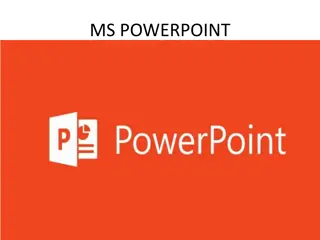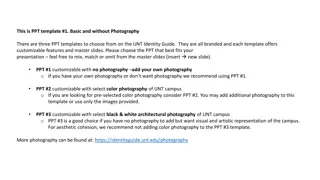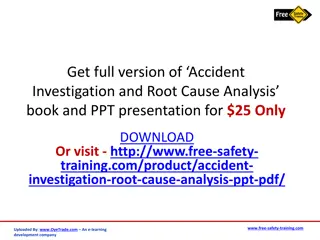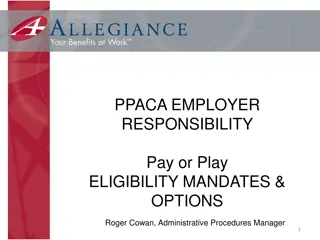PPACA Overview and Key Concepts
Explore the Patient Protection and Affordable Care Act (PPACA) and its key concepts, including employer mandates, individual mandates, implementation complexity, and important terms. Learn about the ACA's impact on employers and individuals, compliance requirements, and penalties for non-compliance.
Download Presentation

Please find below an Image/Link to download the presentation.
The content on the website is provided AS IS for your information and personal use only. It may not be sold, licensed, or shared on other websites without obtaining consent from the author.If you encounter any issues during the download, it is possible that the publisher has removed the file from their server.
You are allowed to download the files provided on this website for personal or commercial use, subject to the condition that they are used lawfully. All files are the property of their respective owners.
The content on the website is provided AS IS for your information and personal use only. It may not be sold, licensed, or shared on other websites without obtaining consent from the author.
E N D
Presentation Transcript
Patient Protection and Affordable Care Act (PPACA) Overview
Outline Overview Key Concepts Definition of Terms Measurement and Stability Periods Section 6056 Reporting Employment Considerations
ACA Overview On March 23, 2010, President Obama signed a comprehensive health reform act into law. Comprehensive legislation that attempts to reform the healthcare system by providing more Americans with Affordable Quality Health Insurance. Key Concepts: Employer Shared-Responsibility or Pay or Play Employer Mandate Individual Mandate
Sounds easy enough. Implementation Complexity Approximately 11,000 pages of regulations 90 provisions 8+ year timeline implementation (2010-2018) Penalties for non-compliance
ACAs Key Concepts EMPLOYER SHARED RESPONSIBILITY AND INDIVIDUAL MANDATES
Employer and Individual Mandates Employer Mandate: Applicable Large Employers (ALE) with at least 50 full-time equivalent employees (full-time is considered 30 hours) are required to offer affordable, minimum value health insurance to their full-time employees. Failure to offer coverage subjects Applicable Large Employers (ALE) to potential tax penalties under section 4980H if an eligible employee enrolls through the exchange and qualifies for a subsidized premium. Individual Mandate: The affordable care act requires nearly everyone to have health insurance that meets minimum standards. With some exceptions, people who do not maintain health insurance coverage will have to pay a penalty as of 2014.
Defining the ACA COCONINO COMMUNITY COLLEGE
Key Terms Temporary Employee Hired to work for a period of 6 months or less. Full-Time Employee Under the ACA, an employee working 30 or more hours a week is considered full-time. A new employee who is reasonably expected to work full-time (average 30 hours per week) at his or her start date for 90 days or more is considered benefits eligible based on ACA rules. Variable Hour Employee A employee is considered a variable hour employee if, based on the facts and circumstances at the start date, it cannot be determined that the employee is reasonably expected to work on average at least 30 hours per week for 90 days. Eligibility cannot be determined on FTE alone. Hours have to be tracked and considered based on IRS guidance
Applying the ACA Stability Period Administrative Period The Administrative Period includes all periods between the start date of a new variable-hour or seasonal employee and the date the employee is first offered coverage under the employer s group health plan, other than the initial measurement period. This provides a period of time to evaluate eligibility and to complete the benefit enrollment process. Standard Measurement Period The Measurement Period or look back period is a safe harbor method to provide employers the option to use a look-back measurement period of up to 12 consecutive calendar months to determine whether variable hour employees or seasonal employees are full-time employees, without being subject to a payment under 4980H for this period with respect to those employees. The period of time a variable hour employee that averaged 30 hours during the Measurement Period would be treated as a full- time employee regardless of the employee s number of hours of service during the stability period, so long as he or she remained an employee. The stability period cannot be less than the measurement period.
Safe Harbors Minimum Essential Coverage Large employers must offer full-time employees (and their dependents) an opportunity to enroll in minimum essential coverage under an employer-sponsored plan Affordability Minimum Value A health plan meets this standard if it is designed to pay at least 60% of the total cost of medical services for a standard population, and if its benefits include substantial coverage of inpatient hospital and physician services. The affordability test looks at each employee uniquely, not the aggregated population. It compares what employees pay for coverage to each employee s wages. Two tests that apply: Minimum Value-which evaluates the comprehensiveness of the plan. 1. The employee s premium contribution for self-only coverage for the lowest cost plan cannot exceed 9.5% of the employee s household income. Affordability-which evaluates an employee s ability to pay for the plan. 2.
Coconino Community College ACA Periods MEASUREMENT PERIODS, ADMINISTRATIVE PERIODS, AND STABILITY PERIODS
Measurement Periods-Ongoing Employee 2014 2016 2017 2015 December March March June March September January January April November November November December December August August August June April April June June September September January February February February July July July October October October May May May May 1st Standard Measurement Period 05/01/14-04/30/15 Stability Period 07/01/15-06/30/16 Admin Period Standard Measurement 05/1/15-04/30/16 Stability Period 07/01/16-06/30/17 Admin Period
Measurement Periods-New Variable Hour Employee 2014 2015 2016 2017 March January March June January March April December September February February February December December May July January May July May July May August August August June June June September October September October October November November November April April Initial Measurement Period 07/01/14-06/30/15 Stability Period 09/01/15-08/31/16 Admin Period Bob F. Standard Measurement Period 05/01/15-04/30/16 Stability Period 07/01/16-06/30/17 Part-Time Tutor hired June 15 Parts on the Initial and Ongoing Measurement Periods Happen Simultaneously Admin Period
Impact on Breaks In Service Length of Break in Service Measurement/Stability Period Break in Service MORE than 26 weeks Treat as new hire - restart and begin new Measurement Period Break in service between 4 26 weeks with amount of prior employment GREATER than break in service Continue existing measurement & stability periods, but do not count break against employee (will average by smaller number of months to exclude the break in service) Treat as new hire - restart and begin new Measurement Period Impacts On Measurement and Stability Periods Break in service between 4 26 weeks with amount of prior employment LESS than break in service Break in Service LESS than 4 weeks Continue existing measurement & stability periods. Factor in zero hours during the break
Section 6056 Reporting FOR APPLICABLE LARGE EMPLOYERS (ALE)
Applicable Large Employers (ALEs) must provide an annual statement to all employees eligible for coverage describing the insurance available to them. The IRS created form 1095-C to serve as that statement. Information on the 1095-C: The employee and the employer. Which months during the year the employee was eligible for coverage. The cost of the cheapest monthly premium the employee could have paid under the plan. What is a 1095-C?
1095-C Employer-Provided Health Insurance Offer and Coverage Insurance. Form 1095-C is filed and furnished to any employee of an ALE who is a full-time employee for one or more months of the calendar year. ALE s must report that information for all twelve months of the calendar year for each employee. Cook, Jayne Coconino Community College 765914213 860795123 2800 S. Lone Tree Rd 2487 N. Butler Avenue (928)2264252 86004 Flagstaff Arizona Arizona Flagstaff 86005 1C 20.00 2C Cook, Sophie Cook, Taylor 555142135 04/28/00 Jayne is a full-time continuous employee, who has two children covered for the entire calendar year. 867530914 01/23/03
Health Insurance Marketplace offers you one-stop shopping to find and compare private health insurance options. Faculty and Staff Without Benefits Who can assist me with Health Insurance Marketplace information, costs, subsidies and online applications? I work at CCC but do not currently qualify for Federally-certified representatives in the marketplace can help you evaluate your coverage options and costs and complete an application. employer-sponsored health benefits. What option do I have Visit www.healthcare.gov under the ACA? 1.800.318.2596
Employment Considerations How does this affect Coconino Community College?
Unique Rules and Challenges for Higher Education Tracking for Higher Education Business Impact Potential Increase in Benefit Enrollments High percentage of Variable employees Managing Compliance Multi-Department employees Budgeting/Forecasting Credit Hour Conversions Notifications Breaks in Service Federal Reporting
Understanding the Penalties Why is this so important to get right? Potential for error: 4980H(a) Coconino Community College fails to offer full- time employee(s) minimum essential coverage during a given month. 658 W2 s issued in 2014** 150 full-time benefit eligible faculty and staff. 450 part-time faculty, staff, students and temporary workers. Full-time employee(s) enroll in the Marketplace and receive a premium tax subsidy. Penalty: $2,000/year ($2,000/12x number of months) Penalty: Penalty is per employee even if just one employee enrolls in the marketplace and receives a subsidy. $2,000/year or $167/month per employee CCC is not subject to the penalty if substantially all (95%) of the full-time employees were offered insurance. 628 (W2 s) x $167.00= $104,876/month $104,876 x 12 months= $1,258,512 million per year ** Based on approximate numbers for purposes of this presentation only.
4980H(b) Penalty Penalty Calculations Penalty is calculated per month, per employee who received subsidy. This penalty may be assessed if a full- time employee enrolls in the exchange/marketplace AND that employee is able to receive a subsidy because the employer coverage is: For example Patty received a subsidy in December: $3,000/12 months x 1 month (December) = $250.00 Penalty Unaffordable Does not provide minimum value 4980H(b) Penalty is larger per incident, but is smaller as an aggregate.
Govtrack.us HealthCare.gov IRS.gov U.S. Department of Human and Health Services Segal Consulting Kaiser Family Foundation References
Questions? Gina Couillard Compliance Specialist Coconino Community College (928)226-4252 Gina.Couillard@Coconino.edu























